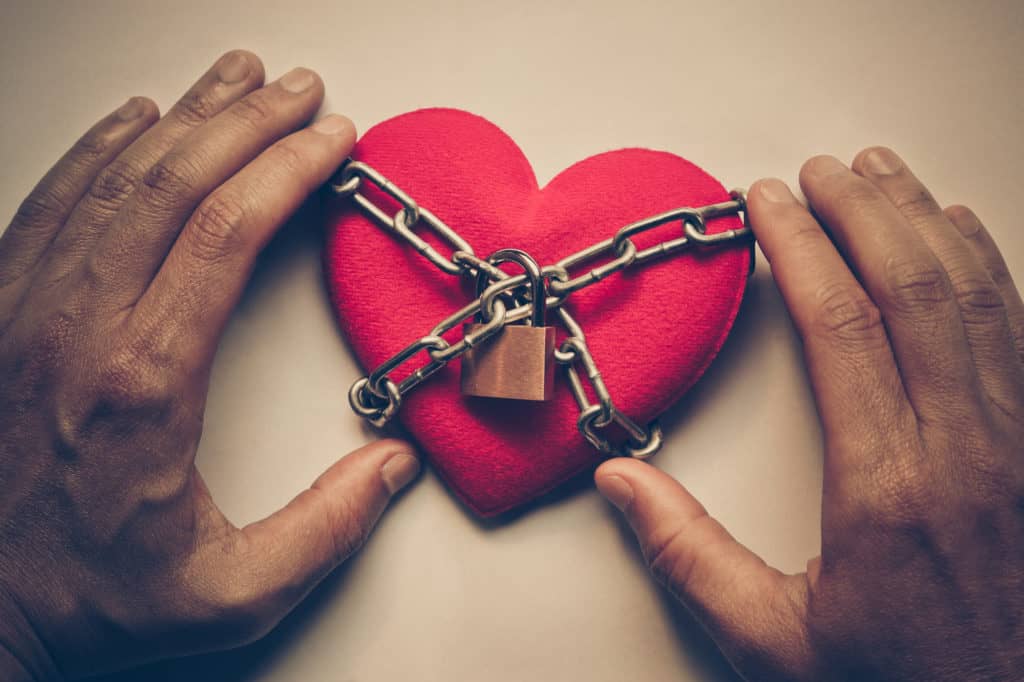
Lots of us find ourselves following the same patterns in our relationships, sometimes having the same problems over and over. Some (though by no means all) of these recurring difficulties may come from our early experiences as children.
In this article, we’re going to look at how childhood experiences can affect our adult relationships (through our attachment style). We’ll look at some simple steps you can take to help you become more securely attached and banish those repeated relationship issues.
You might want to feel more relaxed, calm, and confident in your relationships. Alternatively, you might feel too distant and want to know how to open up and feel closer to the people you care about.
We’re going to look at how to develop a secure attachment style to give you the kind of relationship you want.
Table of Contents

Your attachment style is formed throughout your childhood. It’s based on how your parents and the other people looking after you treated you1. There are four different attachment styles:
Children develop a secure attachment style if their parents pay attention to their needs and show them that they can rely on the people around them.
It’s important to say that not having a secure attachment style doesn’t mean that your parents were ‘bad’. Most parents do their very best for their children. Often, parents pass their own attachment styles on to the next generation, as avoidant parents have avoidant children and anxious ones find that their children are anxious as well.
If you have a secure attachment style, you will usually feel able to express your emotions honestly. You find it easy to trust others and form deep, meaningful relationships with people you can rely on.
If that doesn’t sound like you, that’s ok. Although we all develop an attachment style in childhood, we can still learn to have a secure attachment style as adults.

As children, we develop a secure attachment style because we have learned that the people around us can be trusted to keep us safe and happy. If we didn’t learn this as children, we need to do so as adults.
The easiest way to feel able to trust the people around us is to surround ourselves with trustworthy people. After all, it will be very difficult to build our ability to trust others if we are constantly being let down.
Rather than pushing yourself to trust people you don’t feel sure of (which can be risky), focus on surrounding yourself with people you are sure you can trust. Look for friends, mentors, and even colleagues you feel you can trust and spend more time with.
Lots of us have friends who are great fun to be around but who we don’t fully trust. Try to spend less time with these friends. You might have a good time with them, but it’s better to prioritize the relationships that will be fulfilling in the long term.
Spending time with people you trust lets you feel safe enough to develop a secure attachment style.
Healing an insecure attachment style will be different depending on which type of insecure attachment you have. Try taking an attachment style quiz to understand your current attachment style.
If you find that you have an anxious attachment style, you will probably have a strong fear of rejection. You might want constant reassurance about whether your partner loves you and you probably become jealous quite easily.
If you discover that you have an avoidant attachment style, you probably keep an emotional barrier between you and the people around you. You might describe yourself as very independent but some partners might call you cold or distant.
If your quiz results suggest that you might have a disorganized attachment style, it is probably worth talking to a trained professional about your attachment issues. Disorganized attachment is quite rare and usually comes from serious childhood trauma.
A psychotherapist or trauma specialist can confirm whether your result was accurate (online tests are only approximate, after all) and help you understand what it might mean for you.
Knowing your current attachment style can help you understand your thoughts, feelings, and behaviors. This is essential if you want to heal your underlying wounds and have a more secure attachment style.
People who already have a secure attachment style usually had their needs met by their parents when they were children. You can’t go back in time to fix that, but you can try to meet your own needs now that you are an adult.
Take some time to understand what you are looking for and ask yourself whether this is something you can provide for yourself. For example, if you want to feel that your happiness is important, ask whether you’re making it a priority. If you want someone to be patient with you, are youbeing patient with yourself?
Meeting your own needs (also known as reparenting) means giving yourself the kind of care and support you wish you’d had from others3. This helps you heal your wounds and reduces your anxiety about whether other people will be there for you.
It’s important to say that meeting your own needs doesn’t mean pulling away from other people. Other people can still meet those needs by showing you love, care, patience, and so on.
Use this tool to check whether he actually is who he says he is
Whether you're married or have just started seeing someone, infidelity rates are on the rise and have increased over 40% in the last 20 years, so you have all the right to be worried.
Perhaps you want to know if he's texting other women behind your back? Or whether he has active Tinder or dating profile? Or worse yet, whether he has a criminal record or is cheating on you?
This tool will do just that and pull up any hidden social media and dating profiles, photos, criminal records, and much more to hopefully help put your doubts to rest.
If you have an avoidant attachment style, knowing you can meet your own needs can give you the secure base you need to let others in emotionally. There’s a difference between being able to meet your own needs and always having to.

Setting your own boundaries is key to your ability to feel safe and secure, which is an essential step toward developing a secure attachment style4. Setting boundaries can be a difficult skill to master, but learning to effectively enforce what you will and will not accept from others will pay dividends.
Boundaries can be especially challenging if you have an insecure attachment style. People with an anxious attachment style are often afraid that the people they love will abandon them if they attempt to set and enforce healthy boundaries.
If you have an avoidant attachment style, you will probably find that you want to set many boundaries but that everyone else expects you to be more flexible. No one likes having their boundaries pushed, but those of us with an avoidant attachment style can find this especially hurtful and scary5.
Setting healthy boundaries means taking the time to really understand your needs and being clear about what is and is not ok for you. You might not always know the answer in the heat of the moment.
Practice buying yourself time to make decisions about what you will and won’t do. Rather than being pressured into giving an answer straight away, you can say “I’m not sure I can do that. Let me check and I’ll get back to you”. Buying time helps us make better decisions and can reduce our stress levels6.
Both anxiously and avoidantly attached people often struggle with recognizing their own worth7. Children are constantly trying to make sense of the world. When their needs are consistently not met, they often form a worldview to explain why they don’t deserve love and support.
Sometimes, we can bury our feelings of unworthiness deeply. You might not even realize that you have low self-worth or self-esteem.
Signs of low self-esteem include
Boosting your self-esteem helps to heal some of the attachment wounds you received in childhood. It helps you to feel more complete in yourself which gives you the confidence to be truly vulnerable with loved ones. Speaking of which…
It might sound counterintuitive, but you can start to have a more secure attachment style in your relationships by allowing yourself to be more vulnerable. Being vulnerable lets you form real, intimate connections with other people8.
You don’t have to be entirely open straight away. You can try to just be a little more vulnerable when you feel safe enough. Practice sharing something slightly personal with a friend. Maybe you don’t like a popular movie or you’ve always wanted to visit Spain.
As you become more comfortable opening up, you can start to talk about deeper topics, such as your hopes, fears, and values. Sharing increasingly personal information is an important way to feel closer to others9.
It’s important to realize that being more securely attached doesn’t mean that you don’t feel nervous or insecure sometimes. We all feel that way now and again. Having a secure attachment style means that you can tolerate feeling vulnerable.
You can learn greater security in your romantic relationships by having strong relationships with other people who are important in your life. For some people, this might mean building better relationships with their parents. Others form strong attachments to close friends, mentors, or other family members.
These attachments can be just as important as our romantic relationships for healing our attachment style10. We’ve already talked about meeting your own needs, but having a wider circle of loved ones gives you more people who can give you the care and support you deserve.
Having an insecure attachment style pushes us towards specific ways of dealing with problems in our relationships11. Someone with an anxious attachment style might seek more and more reassurance, while someone more avoidantly attached will start to pull away.
Often, these patterns can damage our current relationships. An anxiously attached person might ‘blow up’ at their partner to get a strong emotional reaction from their partner. An avoidantly attached person might spend more time with friends to avoid dealing with conflict with their partner.
Recognizing and understanding those patterns is the first step to making better choices. Think about how you deal with conflict or problems in your relationship. Try to avoid self-blame or justification. Just try to understand what you do and why you do it, without making value judgments.
Sometimes, these patterns can be in how you think about your relationship, rather than what you do. If you find yourself constantly worrying that your partner is cheating on you (without any evidence), this might be due to an anxious attachment style.
Where you find those repeating thought processes or behavior patterns, take a moment to pause. Try saying “this is painful, but it’s probably more about me than my relationship. I’m going to be brave and try to break that pattern.”
Then try to do something new or different. If you’d usually check your partner’s phone for signs they’re cheating, try asking a close friend for reassurance instead.
If you’d usually pull away from your partner, try being more open. Explain how you’re feeling and ask them to trust you to be able to deal with it.

When we first start to deal with attachment issues, it can be tempting to go all in. That’s understandable. We’re being told how to develop a secure attachment style and promised that we can finally have the kind of relationship we thought was out of reach.
Unfortunately, this enthusiasm usually wanes quickly when we realize that working through attachment trauma can be hard work. It’s better to start gently and try to make slow, continual progress instead of diving in head first.
Maintain your consistency by including a form of self-reflection in your daily routine12. Journaling can be useful, but you could also go for a walk as you think about your relationships or set aside some time for self-reflection over your morning coffee. However you do it, try to be consistent.
If you want to have a more secure attachment style, you might benefit from working with a trained professional. Finding a therapist who works on attachment issues or who specializes in ‘inner child’ work can help you make faster progress.
Experienced relationship coaches can also help you understand some of your deeper, subconscious feelings and beliefs. A good coach or therapist can help you understand what a genuinely safe, caring, and respectful relationship with healthy boundaries should look like.
You can learn a more secure attachment style by building your sense of self-worth, healing childhood hurts, learning to fulfill your own needs, and surrounding yourself with people you can trust and rely on. Becoming more securely attached takes work but it is achievable.
You can move from an anxious to secure attachment style by learning that you deserve to be loved, building the confidence to enforce your own boundaries, and starting to put your own needs first. A qualified therapist can really help with this process.
When you have a secure attachment style, you are able to trust others and form close, intimate relationships. You can talk about your needs and respect the needs of your partner. You’re not afraid of rejection. You love being with your loved ones but you’re not scared of being alone.
People with insecure attachments are typically either hyper-independent or overly clingy. You may also be over-fixated on your relationship or see it as barely important. Secure attachment is more of a middle ground.
Have you enjoyed learning how to develop a secure attachment style? Using these tips will allow you to have closer, more meaningful relationships that make you genuinely happy.
Which of these tips works best for you? Do you have any other suggestions? Let us know in the comments. As always, we want everyone to have the kind of great relationships they deserve, so please do share this article if you found it helpful.
Utilize this tool to verify if he's truly who he claims to be
Whether you're married or just started dating someone, infidelity rates have risen by over 40% in the past 20 years, so your concerns are justified.
Do you want to find out if he's texting other women behind your back? Or if he has an active Tinder or dating profile? Or even worse, if he has a criminal record or is cheating on you?
This tool can help by uncovering hidden social media and dating profiles, photos, criminal records, and much more, potentially putting your doubts to rest.
